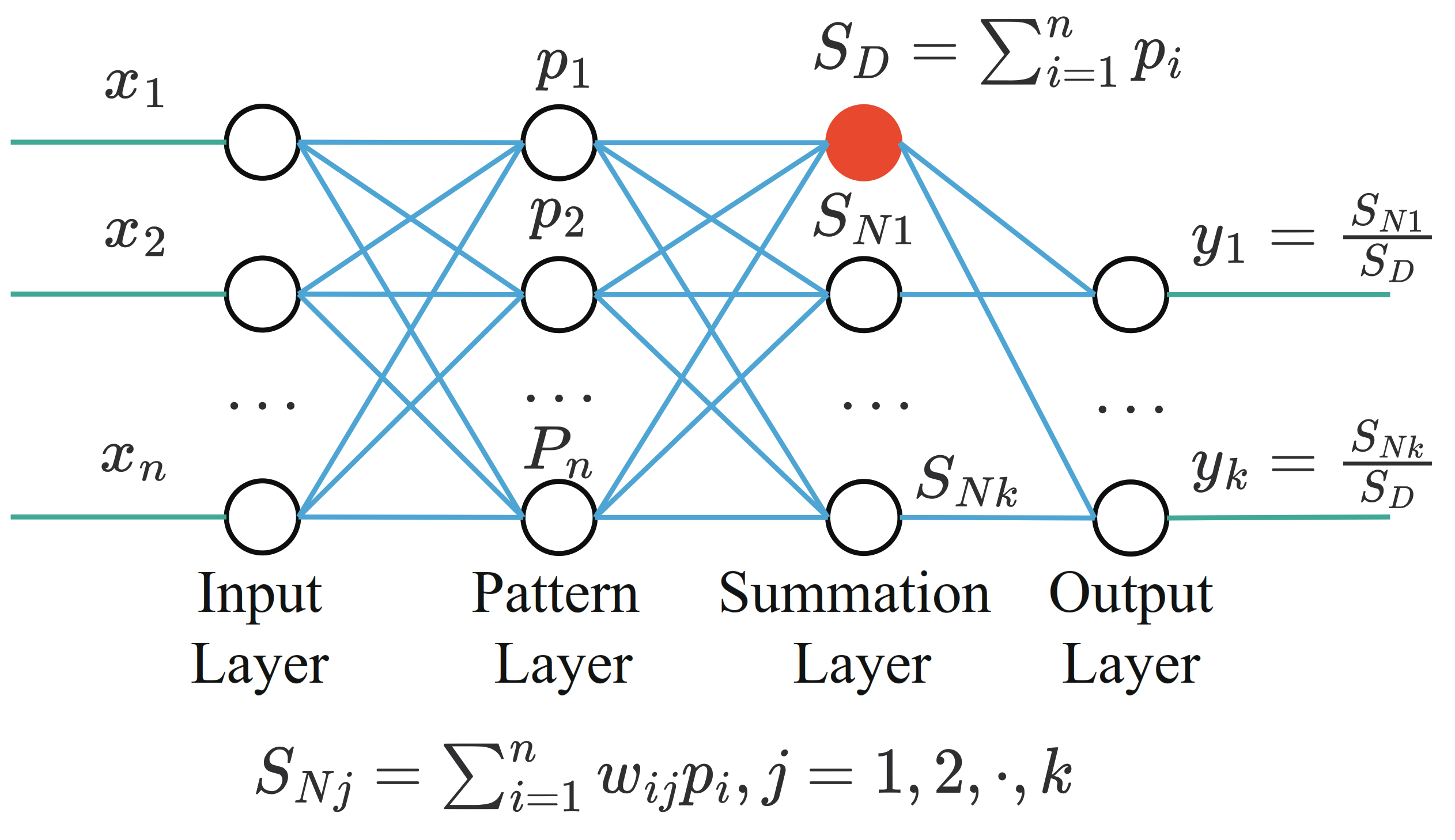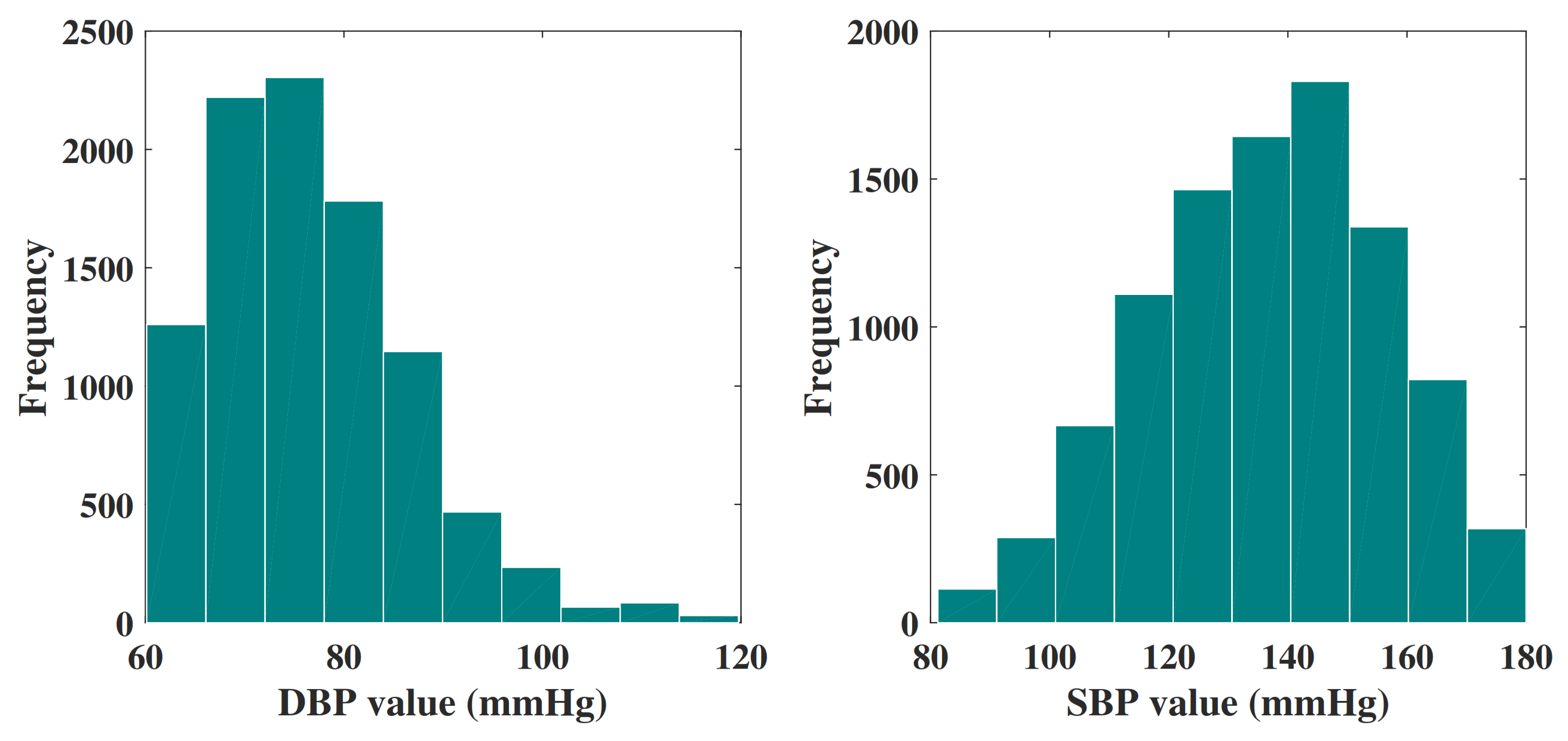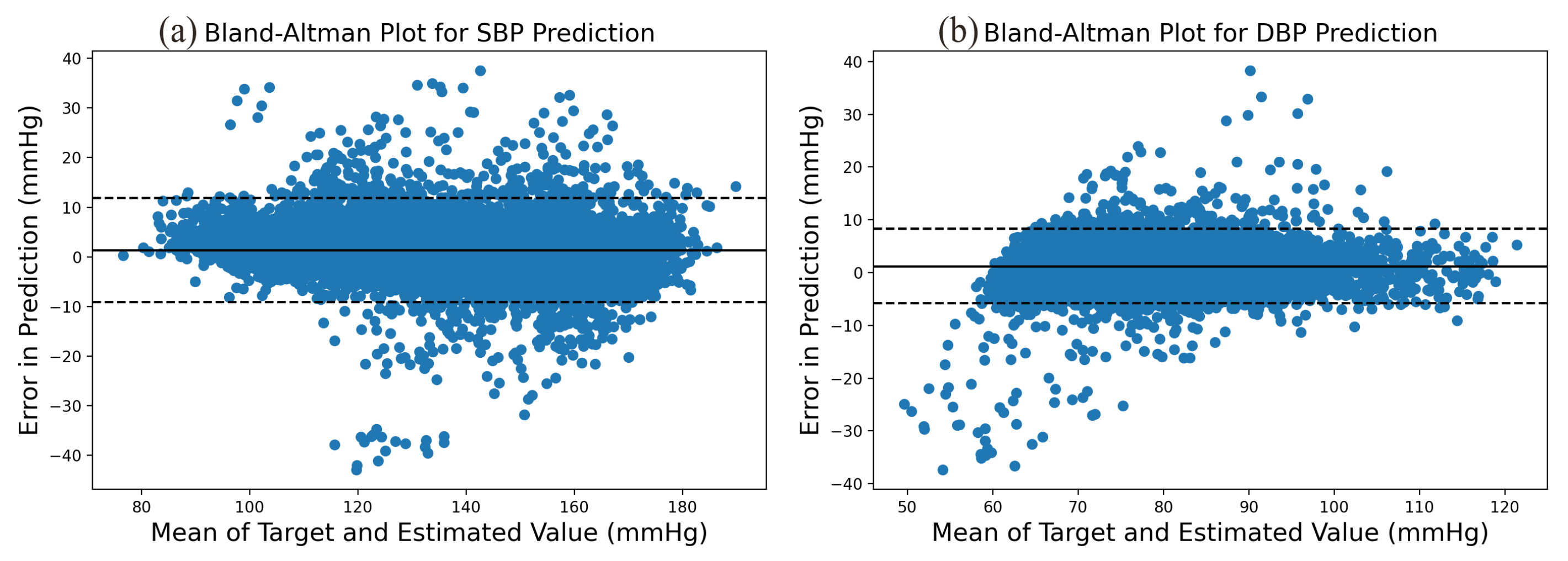A Continuous Blood Pressure Estimation Method Using Photoplethysmography by GRNN-Based Model
Abstract
:1. Introduction
- Estimating continuous and noninvasive BP waveforms directly from the raw PPG signal only, and there is no need for the first and second derivatives of the PPG signal;
- The input of the GRNN net is the amplitude and phase angle of the PPG signal in a specific frequency, no PPG signal features are required, and the model has a low computational burden;
- Our method can not only estimate DBP and SBP but also estimate the BP waveform and frequency domain feature of the BP waveform.
2. Materials and Methods
2.1. Data Preprocessing
2.1.1. Wave Filtering
2.1.2. Abnormal Signal Elimination
- The subjects with very high BP or very low BP were removed. To ensure that SBP is less than 180 and more than 80, DBP is less than 130 and more than 60.
2.1.3. Single-Period Waveform Extraction
2.2. GRNN-Based Model
2.2.1. Encoder and Decoder
2.2.2. GRNN
- The input layer, which is fully connected with the pattern layer. The number of nodes is equal to the feature dimension of the sample;
- The pattern layer, the number of nodes is equal to the number of training samples, the pattern function can be calculated as:where x is input vector, is the training vector corresponding to the i-th neuron, is a hyperparameter of the model and needs to be set in advance.
- The summation layer, the number of nodes is one more than the output sample dimension. The output of the summation layer is divided into two parts. The output of the first node is the arithmetic sum of the output of the mode layer, and the output of the remaining nodes is the weighted sum of the output of the mode layer.
- The output layer, the number of nodes in the output layer is equal to the dimension of the output vector. The output of each node is equal to the output of the corresponding summation layer divided by the output of the first node of the summation layer.

2.2.3. Model Setup
3. Results
4. Discussion
5. Conclusions
Author Contributions
Funding
Institutional Review Board Statement
Informed Consent Statement
Data Availability Statement
Conflicts of Interest
References
- Jain, K.; Jain, S.; Guha, A.; Patra, A. An approach to early stage detection of atherosclerosis using arterial blood pressure measurements. Biomed. Signal Process. Control 2021, 68, 102594. [Google Scholar] [CrossRef]
- Courand, P.Y.; Dinic, M.; Lorthioir, A.; Bobrie, G.; Grataloup, C.; Denarié, N.; Soulat, G.; Mousseaux, E.; Sapoval, M.; Azizi, M.; et al. Resistant hypertension and atherosclerotic renal artery stenosis: Effects of angioplasty on ambulatory blood pressure. A retrospective uncontrolled single-center study. Hypertension 2019, 74, 1516–1523. [Google Scholar] [CrossRef] [PubMed]
- Kocyigit, S.; Aydin, A. Improvement of nutritional status enhances cognitive and physical functions in older adults with orthostatic hypotension. Nutrition 2021, 90, 111261. [Google Scholar] [CrossRef] [PubMed]
- Luckner, G.; Margreiter, J.; Jochberger, S.; Mayr, V.; Luger, T.; Voelckel, W.; Mayr, A.J.; Dünser, M.W. Systolic anterior motion of the mitral valve with left ventricular outflow tract obstruction: Three cases of acute perioperative hypotension in noncardiac surgery. Anesth. Analg. 2005, 100, 1594–1598. [Google Scholar] [CrossRef]
- Karamanoglu, M. A system for analysis of arterial blood pressure waveforms in humans. Comput. Biomed. Res. 1997, 30, 244–255. [Google Scholar] [CrossRef]
- Park, S.H.; Park, Y.S. Can an automatic oscillometric device replace a mercury sphygmomanometer on blood pressure measurement? A systematic review and meta-analysis. Blood Press. Monit. 2019, 24, 265–276. [Google Scholar] [CrossRef]
- Babadağ, K.; Zaybak, A. Comparing Intra-Arterial, Auscultatory, and Oscillometric Measurement Methods for Arterial Blood Pressurem. Florence Nightingale J. Nurs. 2021, 29, 194. [Google Scholar] [CrossRef]
- Maher, N.; Elsheikh, G.; Anis, W.; Emara, T. Enhancement of blood pressure estimation method via machine learning. Alex. Eng. J. 2021, 60, 5779–5796. [Google Scholar] [CrossRef]
- Allen, J. Photoplethysmography and its application in clinical physiological measurement. Physiol. Meas. 2007, 28, R1–R39. [Google Scholar] [CrossRef] [Green Version]
- Fiorini, L.; Cavallo, F.; Martinelli, M.; Rovini, E. Characterization of a PPG wearable sensor to be embedded into an innovative ring-shaped device for healthcare monitoring. In Italian Forum of Ambient Assisted Living; Springer: Cham, Switzerland, 2019; pp. 49–63. [Google Scholar]
- Harfiya, L.N.; Chang, C.C.; Li, Y.H. Continuous Blood Pressure Estimation Using Exclusively Photopletysmography by LSTM-Based Signal-to-Signal Translation. Sensors 2021, 21, 2952. [Google Scholar] [CrossRef]
- Ding, X.; Yan, B.P.; Zhang, Y.T.; Liu, J.; Zhao, N.; Tsang, H.K. Pulse transit time based continuous cuffless blood pressure estimation: A new extension and a comprehensive evaluation. Sci. Rep. 2017, 7, 11554. [Google Scholar] [CrossRef]
- Sharifi, I.; Goudarzi, S.; Khodabakhshi, M.B. A novel dynamical approach in continuous cuffless blood pressure estimation based on ECG and PPG signals. Artif. Intell. Med. 2019, 97, 143–151. [Google Scholar] [CrossRef]
- Liu, J.; Qiu, S.; Luo, N.; Lau, S.K.; Yu, H.; Kwok, T.; Zhang, Y.T.; Zhao, N. PCA-based multi-wavelength photoplethysmography algorithm for cuffless blood pressure measurement on elderly subjects. IEEE J. Biomed. Health Inf. 2020, 25, 663–673. [Google Scholar] [CrossRef]
- Li, Y.H.; Harfiya, L.N.; Purwandari, K.; Lin, Y.D. Real-time cuffless continuous blood pressure estimation using deep learning model. Sensors 2020, 20, 5606. [Google Scholar] [CrossRef]
- Shao, J.; Shi, P.; Hu, S.; Liu, Y.; Yu, H. An Optimization Study of Estimating Blood Pressure Models Based on Pulse Arrival Time for Continuous Monitoring. J. Healthc. Eng. 2020, 2020, 1078251. [Google Scholar] [CrossRef]
- Heydari, F.; Ebrahim, M.P.; Redoute, J.M.; Joe, K.; Walker, K.; Yuce, M.R. A chest-based continuous cuffless blood pressure method: Estimation and evaluation using multiple body sensors. Inf. Fusion 2020, 54, 119–127. [Google Scholar] [CrossRef]
- Nabeel, P.; Karthik, S.; Joseph, J.; Sivaprakasam, M. Arterial blood pressure estimation from local pulse wave velocity using dual-element photoplethysmograph probe. IEEE Trans. Instrum. Meas. 2018, 67, 1399–1408. [Google Scholar] [CrossRef]
- Mousavi, S.S.; Firouzmand, M.; Charmi, M.; Hemmati, M.; Moghadam, M.; Ghorbani, Y. Blood pressure estimation from appropriate and inappropriate PPG signals using A whole-based method. Biomed. Signal Process. Control 2019, 47, 196–206. [Google Scholar] [CrossRef]
- Thambiraj, G.; Gandhi, U.; Mangalanathan, U.; Jose, V.J.M.; Anand, M. Investigation on the effect of Womersley number, ECG and PPG features for cuff less blood pressure estimation using machine learning. Biomed. Signal Process. Control 2020, 60, 101942. [Google Scholar] [CrossRef]
- Beutel, F.; Van Hoof, C.; Rottenberg, X.; Reesink, K.; Hermeling, E. Pulse Arrival Time Segmentation into Cardiac and Vascular Intervals–Implications for Pulse Wave Velocity and Blood Pressure Estimation. IEEE Trans. Biomed. Eng. 2021, 68, 2810–2820. [Google Scholar] [CrossRef]
- Hsu, Y.C.; Li, Y.H.; Chang, C.C.; Harfiya, L.N. Generalized deep neural network model for cuffless blood pressure estimation with photoplethysmogram signal only. Sensors 2020, 20, 5668. [Google Scholar] [CrossRef]
- Senturk, U.; Polat, K.; Yucedag, I. A non-invasive continuous cuffless blood pressure estimation using dynamic recurrent neural networks. Appl. Acoust. 2020, 170, 107534. [Google Scholar] [CrossRef]
- El Hajj, C.; Kyriacou, P.A. Cuffless and continuous blood pressure estimation from ppg signals using recurrent neural networks. In Proceedings of the 2020 42nd Annual International Conference of the IEEE Engineering in Medicine & Biology Society (EMBC), Montreal, QC, Canada, 20–24 July 2020; pp. 4269–4272. [Google Scholar]
- Slapničar, G.; Mlakar, N.; Luštrek, M. Blood pressure estimation from photoplethysmogram using a spectro-temporal deep neural network. Sensors 2019, 19, 3420. [Google Scholar] [CrossRef] [Green Version]
- Jamal, E.; Mohammad Hassan, M.; Abdolrahim, K. A multistage deep neural network model for blood pressure estimation using photoplethysmogram signals. Comput. Biol. Med. 2020, 120, 103719. [Google Scholar]
- Wang, X.; Xu, J.; Shi, W.; Liu, J. OGRU: An optimized gated recurrent unit neural network. J. Phys. Conf. Ser. 2019, 1325, 012089. [Google Scholar] [CrossRef]
- Cheng, J.; Xu, Y.; Song, R.; Liu, Y.; Li, C.; Chen, X. Prediction of Arterial Blood Pressure Waveforms from Photoplethysmogram Signals via Fully Convolutional Neural Networks. Comput. Biol. Med. 2021, 138, 104877. [Google Scholar] [CrossRef]
- Zhang, H. A Novel Frequency Domain Arterial Tree Model: Distributed Wave Reflections and Potential Clinical Applications. Ph.D. Thesis, Rutgers, The State University of New Jersey, New Brunswick, NJ, USA, 2006. [Google Scholar]
- Li, Z.; Wei, H. Stenosis diagnosis based on peripheral arterial and artificial neural network. Netw. Model. Anal. Health Inform. Bioinform. 2021, 10, 13. [Google Scholar] [CrossRef]
- Arvanaghi, R.; Daneshvar, S.; Seyedarabi, H.; Goshvarpour, A. Classification of cardiac arrhythmias using arterial blood pressure based on discrete wavelet transform. Biomed. Eng. Appl. Basis Commun. 2017, 29, 1750034. [Google Scholar] [CrossRef]
- Goldberger, A.L.; Amaral, L.A.; Glass, L.; Hausdorff, J.M.; Ivanov, P.C.; Mark, R.G.; Mietus, J.E.; Moody, G.B.; Peng, C.K.; Stanley, H.E. PhysioBank, PhysioToolkit, and PhysioNet: Components of a new research resource for complex physiologic signals. Circulation 2000, 101, e215–e220. [Google Scholar] [CrossRef] [Green Version]
- Kachuee, M.; Kiani, M.M.; Mohammadzade, H.; Shabany, M. Cuffless blood pressure estimation algorithms for continuous health-care monitoring. IEEE Trans. Biomed. Eng. 2016, 64, 859–869. [Google Scholar] [CrossRef]
- van Gent, P.; Farah, H.; Nes, N.; van Arem, B. Heart rate analysis for human factors: Development and validation of an open source toolkit for noisy naturalistic heart rate data. In Proceedings of the 6th HUMANIST Conference, Hague, The Netherlands, 13–14 June 2018; pp. 173–178. [Google Scholar]
- Martínez, G.; Howard, N.; Abbott, D.; Lim, K.; Ward, R.; Elgendi, M. Can photoplethysmography replace arterial blood pressure in the assessment of blood pressure? J. Clin. Med. 2018, 7, 316. [Google Scholar] [CrossRef] [PubMed] [Green Version]
- Specht, D.F. A general regression neural network. IEEE Trans. Neural Netw. 1991, 2, 568–576. [Google Scholar] [CrossRef] [Green Version]
- Liu, M.; Po, L.M.; Fu, H. Cuffless blood pressure estimation based on photoplethysmography signal and its second derivative. Int. J. Comput. Theory Eng. 2017, 9, 202–206. [Google Scholar] [CrossRef] [Green Version]
- Eom, H.; Lee, D.; Han, S.; Hariyani, Y.S.; Lim, Y.; Sohn, I.; Park, K.; Park, C. End-to-end deep learning architecture for continuous blood pressure estimation using attention mechanism. Sensors 2020, 20, 2338. [Google Scholar] [CrossRef] [PubMed] [Green Version]
- Athaya, T.; Choi, S. An estimation method of continuous non-invasive arterial blood pressure waveform using photoplethysmography: A U-Net architecture-based approach. Sensors 2021, 21, 1867. [Google Scholar] [CrossRef] [PubMed]
- O’Brian, E.; Petrie, J.; Littler, W.; de Swiet, M.; Padfield, P.L.; O’Malley, K.; Jamieson, M.; Altman, D.; Bland, M.; Atkins, N. The British Hypertension Society protocol for the evaluation of automated and semi-automated blood pressure measuring devices with special reference to ambulatory systems. J. Hypertens. 1990, 8, 607–619. [Google Scholar]
- Stergiou, G.S.; Alpert, B.; Mieke, S.; Asmar, R.; Atkins, N.; Eckert, S.; Frick, G.; Friedman, B.; Graßl, T.; Ichikawa, T.; et al. A universal standard for the validation of blood pressure measuring devices: Association for the Advancement of Medical Instrumentation/European Society of Hypertension/International Organization for Standardization (AAMI/ESH/ISO) Collaboration Statement. J. Hypertens. 2018, 71, 368–374. [Google Scholar] [CrossRef]










| Model | SBP(mmHg) | DBP(mmHg) | ||
|---|---|---|---|---|
| MAE | RMSE | MAE | RMSE | |
| Support Vector Regression (SVR) [37] | 8.54 | 10.9 | 4.34 | 5.8 |
| Generalized Deep Neural Network (GDNN) [22] | 3.21 | 4.63 | 2.23 | 3.21 |
| Enhanced regression model (ERM) [8] | 4.24 | 5.06 | 4.81 | 6.37 |
| Long Short-Term Memory (LSTM) [11] | 4.05 | 5.25 | 2.41 | 3.17 |
| End-To-End Deep Learning Architecture(ETE) [38] | 4.06 | 5.42 | 3.33 | 4.30 |
| Convolutional neural network (CNN) [39] | 3.68 | 5.75 | 1.97 | 3.52 |
| Our model | 3.96 | 5.54 | 2.39 | 3.45 |
| Cumulative Error Percentage | ||||
|---|---|---|---|---|
| Error | ≤5 mmHg | ≤10 mmHg | ≤15 mmHg | |
| Our result | SBP | 80.1% | 93.9% | 97.6% |
| DBP | 93.9% | 98.1% | 99.2% | |
| BHS | Grade A | 60% | 85% | 95% |
| Grade B | 50% | 75% | 90% | |
| Grade C | 40% | 65% | 85% | |
| MAE | STD | Subjects | ||
|---|---|---|---|---|
| Our result | SBP | 3.96 | 5.36 | 3183 |
| DBP | 2.39 | 3.28 | 3183 | |
| AAMI | <5 | <8 | >85 | |
| Evaluation Factor | CNN Model [39] | Our Model |
|---|---|---|
| Average r | 0.993 | 0.981 |
| Minimum r | 0.262 | 0.321 |
| Maximum r | 0.999 | 0.999 |
| 25th percentile of r | 0.989 | 0.976 |
| 75th percentile of r | 0.996 | 0.992 |
Publisher’s Note: MDPI stays neutral with regard to jurisdictional claims in published maps and institutional affiliations. |
© 2021 by the authors. Licensee MDPI, Basel, Switzerland. This article is an open access article distributed under the terms and conditions of the Creative Commons Attribution (CC BY) license (https://creativecommons.org/licenses/by/4.0/).
Share and Cite
Li, Z.; He, W. A Continuous Blood Pressure Estimation Method Using Photoplethysmography by GRNN-Based Model. Sensors 2021, 21, 7207. https://doi.org/10.3390/s21217207
Li Z, He W. A Continuous Blood Pressure Estimation Method Using Photoplethysmography by GRNN-Based Model. Sensors. 2021; 21(21):7207. https://doi.org/10.3390/s21217207
Chicago/Turabian StyleLi, Zheming, and Wei He. 2021. "A Continuous Blood Pressure Estimation Method Using Photoplethysmography by GRNN-Based Model" Sensors 21, no. 21: 7207. https://doi.org/10.3390/s21217207
APA StyleLi, Z., & He, W. (2021). A Continuous Blood Pressure Estimation Method Using Photoplethysmography by GRNN-Based Model. Sensors, 21(21), 7207. https://doi.org/10.3390/s21217207





